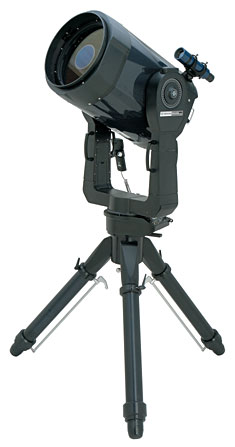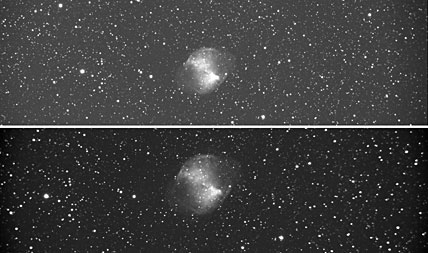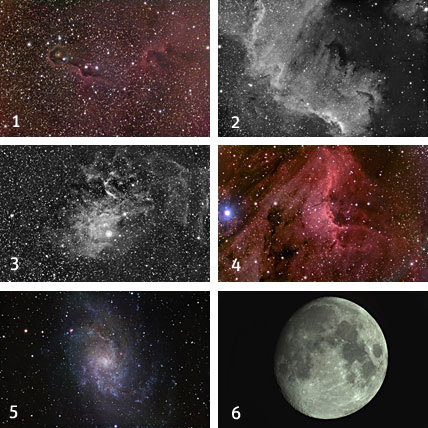
The 12-inch RCX400 telescope from Meade Instruments, shown on its field tripod.
S&T photo by Craig Michael Utter.
When Meade Instruments announced its new RCX400 line of catadioptric telescopes in early 2005, it created such a buzz in the astronomical community that I visited the company's Irvine, California, headquarters to look at prototypes and talk with the people spearheading the project. My preview of the scopes based on that trip appears in the May 2005 Sky & Telescope, page 86. In case you don't have that issue handy, a 284-kilobyte PDF of the article is available in Sky Publishing's Magazine Archive (you'll need a copy of the free Adobe Reader software to open it). The PDF is free for online-archive subscribers and $3.95 for everyone else:
My subsequent S&T Test Report on the RCX400 (12-inch model) appears in the February 2006 issue, page 78, and is also available in Sky Publishing's Magazine Archive. As noted in that review, visual observers will enjoy many of the advanced features built into the new scopes, but it is astrophotographers who will benefit the most, and for that reason I concentrated much of my testing on the RCX400's imaging potential. Because of space limitations, it was impossible to run the images in the magazine at a scale sufficient to show the fine detail visible in the originals while still showing the entire field of view. Thus we are supplying several of the images here at higher resolution, along with a few more that didn't run with the review.
I am indebted to my editorial colleague Sean Walker for his efforts in processing these images. We talked at length about our philosophy before he began his work. There are many processing tricks that can improve image quality, but because these images were meant for a product review, we wanted to show them as close to their original quality as possible. Thus, the photographs presented here have not had their star images altered by sharpening routines. Sean has processed the data just enough to produce images that have a pleasing contrast and, where appropriate, color balance, often using nonlinear stretching to enhance the appearance of faint nebulosity without "burning out" the brighter areas.
As explained in the magazine review, all my testing was done using the scope in "portable" mode — the scope was stored in my home and set up in my front yard for each observing session. I feel that the results I got were rather impressive for a system used this way.

The difference in off-axis performance of Meade's 12-inch RCX400 (top) and LX200 Schmidt-Cassegrain telescopes is apparent in these 5-minute exposures of M27, the Dumbbell Nebula, made with an SBIG STL-11000M CCD camera. Because of the RCX400's shorter focal length, it covers a 22 percent wider field than the LX200. Click on the image to download a high-resolution version (444-kilobyte JPEG) by anonymous FTP. Then look at the left and right edges of the high-res file and examine the star images at 100%.
S&T photos by Dennis di Cicco.
Another thing that impresses me about these images is that, apart from my laptop computer, the only products involved were the RCX400 and an SBIG STL-11000M CCD camera, which has a chip the size of a 35-mm film frame. I never needed so much as an extra wire or setscrew beyond what was included in the box with the telescope and camera. While that may not seem exceptional to someone new to astrophotography, my involvement with the hobby goes back to a time when most successful astrophotographers had to custom build major parts of their setups.
The weakest link in my RCX400 astrophotography setup was the connection between the telescope and the camera. There was a difference of about 0.010 inch between the camera's 2-inch nosepiece and the eyepiece holder on the RCX400. I had to be very careful when tightening the thumbscrews of the eyepiece holder in order to prevent the camera from becoming slightly cocked to one side. This would be less of a problem for a camera with a smaller chip, but in the case of the STL-11000M, having the camera just slightly tipped caused the star images to appear different on one side of the frame than on the other. In the dark, I wasn't always successful at getting the camera exactly square to the eyepiece holder. A simple piece of shim stock would have helped.
The high-resolution views made available here have been reduced 50 percent from the originals and saved as JPEG files simply to keep them manageable for downloading. A full-resolution, uncompressed, tricolor original made with the STL-11000M is larger than 60 megabytes. While details vary slightly, my black-and-white images of emission nebulae were typically the result of 1 hour of exposure through a red filter, while color images were the result of 1 to 2 hours of combined exposure through the camera's red, green, and blue filters. Except for cropping the edges of the frame to remove the slight amount of uneven overlap from the stacked images, these views are full frame. You can quickly judge the image scale from the Moon picture made on the evening of December 12th specifically for the purpose of including it here.

High-resolution versions of these six images are available for download by anonymous FTP so that you can better evaluate the image quality of Meade's 12-inch RCX400 telescope. Numbers correspond to the links below.
S&T photos by Dennis di Cicco and Sean Walker.
Click on the following links to download (by anonymous FTP) the ½-megabyte high-resolution image files:
1. vdB 142 complex in Cepheus (part of the emission nebula IC 1396)
2. "Yucatán peninsula" region of the North America Nebula in Cygnus
3. Flame Nebula, IC 405, in Auriga at f/5 cropped to DSLR format
4. "Head and neck" region of the Pelican Nebula, IC 5067, in Cygnus
 0
0









Comments
You must be logged in to post a comment.